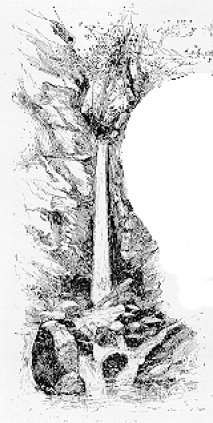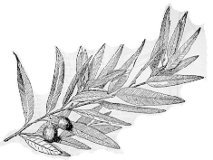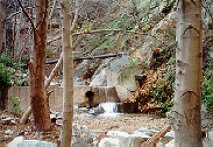A Journey Into Millard Canyon
Flora, Fauna, and Survival
Skills
By Christopher Nyerges
My first introduction to Millard Canyon was the
magnificent waterfall. You drive up Chaney Trail, and then down
the road to the campsite. A relatively short hike under the oaks
and bays gets you  to the
base of the waterfall, a favorite spot for families and
picnickers in summer. I like it, but I always avoid it in summer
and on weekends because whenever a spot gets too popular, the
trash and diapers increase, and there tend to be radios playing
the current junk music.
to the
base of the waterfall, a favorite spot for families and
picnickers in summer. I like it, but I always avoid it in summer
and on weekends because whenever a spot gets too popular, the
trash and diapers increase, and there tend to be radios playing
the current junk music.
I prefer behind the waterfall, up towards the
Dawn Mine. To get there, you park your car at the T-intersection
at the top of Chaney Trail, and walk up the road for a
quarter-mile or so until you come to the dirt trail off to your
left. This is a pleasant trail, planted with rosemary at the entrance, and
lined with such native plants as wild cherry, elderberries, oak
trees, yerba santa, and yucca. Yellow mustard flowers are common,
and I enjoy picking the flowers and nibbling the broccoli-flavor
flowers as I walk. The yerba santa was used back in the old days
as medicine, and you can pinch off a bit of the leaf and chew on
it as you walk. The flavor may seem strange at first but you get
used to it.
At least three soap plants can be found along
this trail leading down to the stream. Yucca, of course, is
somewhat common. When you read the tales of the native peoples of
the Southwest, you always hear about using yucca roots for soap.
But, to just wash your hands, please don’t ever dig up an
entire yucca plant. It’s not even practical. But you can
snip off one lower leaf, shred it into fibers, wet it and agitate
between the hands, and you’ve got a wonderful, thick soap.
Soap root or amole is also found on the hillsides here and there,
but you’d probably need to have someone point it out. It is
a large underground bulb with wavy leaves that you see in the
spring. During most of the year, there is little to tell you that
the bulbs are down there. This is possibly one of the best wild
soap sources I have ever tried. The crushed bulb is mixed with
water and agitated between the hands. You get a thick rich soap
good for shampoo, washing your filthy clothes, or cleaning the
dog. (Hear that, Cassius? Time for a bath! Woof, woof!)
And there is also the mountain lilac bush,
conspicuous in the spring by its white or purple flowers. You can collect
either the flowers or the sticky fruits, add some water, rub them
between your hands, and get a mildly aromatic natural soap.
 As you continue down this dirt
trail, you’ll see lots of bay trees. Their leaves are richly
aromatic and can be used to make a good tea or to flavor your
spaghetti sauce. Even the nuts which fall from the trees in the
fall can be collected and eaten (once roasted or boiled -- they
are bitter raw).
As you continue down this dirt
trail, you’ll see lots of bay trees. Their leaves are richly
aromatic and can be used to make a good tea or to flavor your
spaghetti sauce. Even the nuts which fall from the trees in the
fall can be collected and eaten (once roasted or boiled -- they
are bitter raw).
Eventually, you’ll pass Mr. Nohr’s
cabin. The story I have heard over the years is that he hauled
all the building supplies in to the site on a wheelbarrow. Nohr
was somewhere in the canyon during the massive floods of 1938, and reported
that there were boulders as big as houses coming down the canyon
and that the noise was "beyond description." Wow! I was
born too late for all that excitement -- but, as they say,
history repeats itself.
Hiking upstream in Millard is a pleasant
experience. The river bottom is mostly lined with tall alders,
interspersed with oaks, sycamores, and bay. The trail meanders
back and forth across the stream, and gets steeper a half-mile or
so below the Dawn Mine.
As for the mine, it’s dangerous, and I
suggest you stay out! Man-made mines are notorious for cave-ins,
for lacking oxygen, and for trapping people who explore
unprepared. A friend from Glendale, Charles Feibush, reported to
me his discovery of the Dawn Mine. He and his buddy were all
excited, and they climbed up and explored inside with their tiny
penlight. After a while -- Charles thinks he was somewhere near
the vertical shaft inside the mine -- he looked up and shined his
light and saw two eyes at about his eye level staring back.
Charles said, "Christopher, you wouldn’t believe how
quickly we got out of that cave!" After thinking about it,
he realized he was probably staring at a mountain lion, and he
was darn lucky it didn’t attack, since a mountain lion is
known to attack things that run from it. Anyway, Charles got home
safe but shaken.
So, what should you always carry with you in
the event you get lost or hurt?
Carry at least a good knife, a magnesium fire starter, and some twine.
Those are the basics and can be used for countless tasks. A water
container and first aid kit are also good things to carry. And
though I typically drink right out of Millard Canyon, it’s
not a bad idea to have some means to purify water. Why? Well,
even if the  water
tests free of various bacteria and other critters, I can recall
the time I encountered a dead deer right in the stream. It was
pretty well decomposed by the time I saw it, and I don’t
think I would have felt too well that evening had I drunk
downstream of the deer. (Gasp!). Boiling water is the easiest way
to purify it, but if you don’t want to take the time or if a
fire is unsafe, you should either carry an iodine crystal kit, or
carry any of the water purification pumps that you can buy at
Sport Chalet stores.
water
tests free of various bacteria and other critters, I can recall
the time I encountered a dead deer right in the stream. It was
pretty well decomposed by the time I saw it, and I don’t
think I would have felt too well that evening had I drunk
downstream of the deer. (Gasp!). Boiling water is the easiest way
to purify it, but if you don’t want to take the time or if a
fire is unsafe, you should either carry an iodine crystal kit, or
carry any of the water purification pumps that you can buy at
Sport Chalet stores.
You should also consider getting a copy of John Robinson’s "Trails of the Angeles," the best book on the trails in our local mountains.
Nyerges is the author of Guide
to Wild Foods, available locally at O Happy Days in Altadena,
Vromans bookstore in Pasadena, and at all Sport Chalet
stores. He has been leading outdoor classes since 1974, and
the schedule is available from School of Self-Reliance, Box
41834, Eagle Rock, CA 90041, or on-line at http://home.earthlink.net/~nyerges/.
Send email to Echowebmaster@aaaim.com to report any problems.
Last modified: February 12, 1999
No part of this paper may be
reproduced in any form without written permission from:
Jake Brouwer
All articles and photos were provided by:
Land-Sea Discovery Group
Copyright © 1999
 to the
base of the waterfall, a favorite spot for families and
picnickers in summer. I like it, but I always avoid it in summer
and on weekends because whenever a spot gets too popular, the
trash and diapers increase, and there tend to be radios playing
the current junk music.
to the
base of the waterfall, a favorite spot for families and
picnickers in summer. I like it, but I always avoid it in summer
and on weekends because whenever a spot gets too popular, the
trash and diapers increase, and there tend to be radios playing
the current junk music.  As you continue down this dirt
trail, you’ll see lots of bay trees. Their leaves are richly
aromatic and can be used to make a good tea or to flavor your
spaghetti sauce. Even the nuts which fall from the trees in the
fall can be collected and eaten (once roasted or boiled -- they
are bitter raw).
As you continue down this dirt
trail, you’ll see lots of bay trees. Their leaves are richly
aromatic and can be used to make a good tea or to flavor your
spaghetti sauce. Even the nuts which fall from the trees in the
fall can be collected and eaten (once roasted or boiled -- they
are bitter raw). water
tests free of various bacteria and other critters, I can recall
the time I encountered a dead deer right in the stream. It was
pretty well decomposed by the time I saw it, and I don’t
think I would have felt too well that evening had I drunk
downstream of the deer. (Gasp!). Boiling water is the easiest way
to purify it, but if you don’t want to take the time or if a
fire is unsafe, you should either carry an iodine crystal kit, or
carry any of the water purification pumps that you can buy at
Sport Chalet stores.
water
tests free of various bacteria and other critters, I can recall
the time I encountered a dead deer right in the stream. It was
pretty well decomposed by the time I saw it, and I don’t
think I would have felt too well that evening had I drunk
downstream of the deer. (Gasp!). Boiling water is the easiest way
to purify it, but if you don’t want to take the time or if a
fire is unsafe, you should either carry an iodine crystal kit, or
carry any of the water purification pumps that you can buy at
Sport Chalet stores.